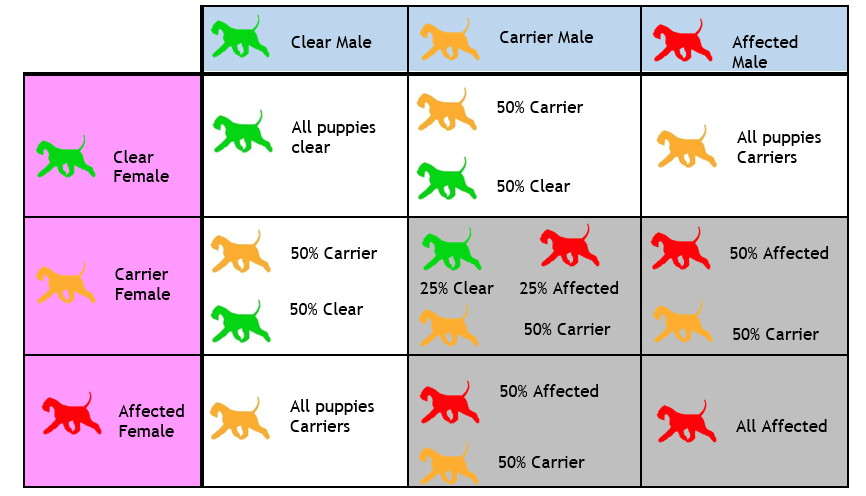Breeding From A DNA Tested Dog

prcd-PRA / DCM / PRA5 (NECAP1)
Currently in Giant Schnauzers we have mainly three seperate DNA tests available to assist breeders with breeding decisions that relate to specific health conditions. The first is for a particular type of Progressive Retinal Atrophy; prcd-PRA which causes blindness, and the second is for a particular type of Dilated Cardiomopathy (DCM) that usually occurs in young dogs, and is a heart condition which is often fatal. The third is for a different type of PRA – PRA5 (NECAP1) found in the Giant Schnauzer and also causes blindness. These DNA tests are for conditions classed as autosomal recessive.
This means a dog must inherit two copies of an abnormal gene before its health is affected. Each dog inherits one copy of a gene from its mother and one from its father. If the health status of both sire and dam are known, the likely health status of any puppies produced can be predicted. A dog can be used responsibly in a breeding programme without the risk of producing clinically affected puppies, PROVIDED THE RIGHT MATE IS SELECTED.
For each of these DNA tests, prcd-PRA, DCM and PRA5, the result will be either clear, carrier or affected.
 Clear means the dog doesn’t have any copies of the abnormal gene and will not be clinically affected by the disorder. Only a normal copy of the gene will be passed to any offspring. Clear dogs can be mated to any dog without producing affected puppies.
Clear means the dog doesn’t have any copies of the abnormal gene and will not be clinically affected by the disorder. Only a normal copy of the gene will be passed to any offspring. Clear dogs can be mated to any dog without producing affected puppies.
 Carrier means the dog has one copy of the normal gene and one copy of the abnormal gene. The dog will not usually be clinically affected by the disorder, but will pass on either one copy of the normal gene, or one copy of the abnormal gene to its offspring. Carrier dogs can only be mated to clear dogs.
Carrier means the dog has one copy of the normal gene and one copy of the abnormal gene. The dog will not usually be clinically affected by the disorder, but will pass on either one copy of the normal gene, or one copy of the abnormal gene to its offspring. Carrier dogs can only be mated to clear dogs.
 Affected means the dog has two copies of the abnormal gene and will be clinically affected by the disorder. An abnormal copy of the gene will be passed on to any offspring. Affected dogs could only be mated to clear dogs without risking producing affected puppies, however all resulting puppies will be carriers. Mating an affected dog to a carrier, or another affected dog is putting the health of future puppies at risk.
Affected means the dog has two copies of the abnormal gene and will be clinically affected by the disorder. An abnormal copy of the gene will be passed on to any offspring. Affected dogs could only be mated to clear dogs without risking producing affected puppies, however all resulting puppies will be carriers. Mating an affected dog to a carrier, or another affected dog is putting the health of future puppies at risk.

Percentages show the ‘chance’ of puppies having the status identified
Producing affected puppies that will develop prcd-PRA, PRA5 or DCM will have a serious impact on their health and welfare. A mating which may produce affected puppies should not be carried out i.e. a carrier should not be bred to another carrier, or an affected, and affected dogs should not be bred together.
The Kennel Club advise that when used responsibly, carriers are an important part of any breeding plan and should not be overlooked. By breeding from carriers, you can keep good, healthy dogs in the breeding population, helping to maintain genetic diversity. However, it would be beneficial to DNA test offspring (particularly those that may be bred from) with the aim of producing only clear puppies in any future generations, thereby reducing the frequency of the abnormal gene in the breed. New owners of any potential carrier puppies should be informed, and placing breeding endorsements and appropriately written contracts may help to ensure they are not bred to another carrier or affected dog in the future.
Similarly, an affected dog with such an autosomal recessive condition could still theoretically be used in a breeding programme, but this will very much be dependent on the condition and whether the dog’s welfare would be affected by the mating/whelping process e.g. such as with a serious heart condition like DCM. An affected dog should not be bred to a carrier or another affected dog as affected puppies will result.
The Kennel Club also point out that a carrier or affected dog should not be “over used”. Over using these dog’s risks increasing the frequency of the faulty gene within the population, making it more difficult for future generations to breed without increasing the risk of producing affected dogs.
The aim should be to produce unaffected puppies, maintain genetic diversity and minimise the number of carriers within the population.
